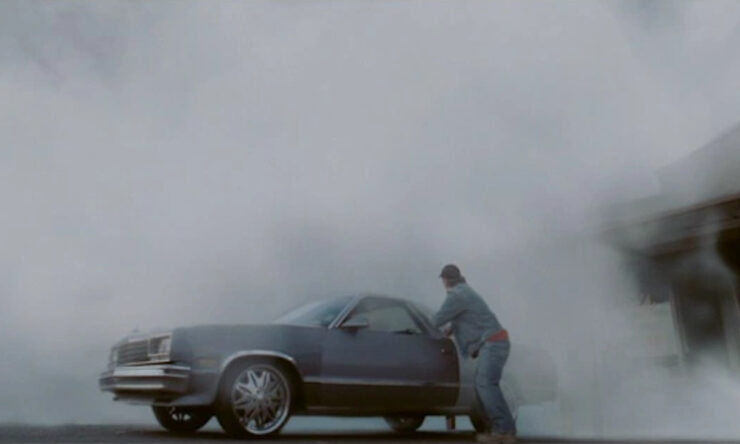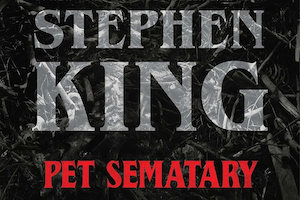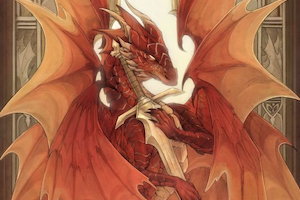Welcome back to Reading the Weird, in which we get girl cooties all over weird fiction, cosmic horror, and Lovecraftiana—from its historical roots through its most recent branches.
This week, we cover Gemma Files’ “The Harrow,” first published in The Children of Old Leach in 2014; we found it in Scott R. Jones’s Cthonic: Weird Tales of Inner Earth anthology. Spoilers ahead!
“…what we don’t understand, we fear… and what we fear, eventually, we come to worship, if only to keep it in its rightful place.”
Lydie Massenet learned about the dangers of inner earth from her mother Irma, both before and after Irma was hospitalized for schizophrenia. The earth was “old and full of holes.” Its crust was “thin ice, waiting for it to thaw and crack.” No need to dig. “If they want to find you,” Irma insisted, “they will. Never trust anything that comes out of a hole.”
Okay, Mom, Lydie’s father taught her to respond. Smile and nod while Irma elaborated: Darkness shifts and conceals – you just can’t tell what hides inside it. One day Lydie’s rote agreement enrages Irma into slapping her. That’s when Irma goes away for good.
Lydie marries Ethan. They live in Toronto until Ethan’s company moves to Mississauga. Used to a city where public transport and walking get one everywhere, Lydie’s never learned to drive. Out in “the suburbs squared,” she’ll need that driver’s license – the closest shopping is twenty minutes away by car. In the meantime, she gets what exercise she can from strolling in the backyard. Something hard shifts under the smooth lawn, almost tripping her. Finger-digging produces a carving in black rock: an insect with short horns. Where its thorax should be, there’s a human skull with a neat hole drilled into its brow ridge.
The artifact fascinates Lydie, who took college archaeology courses. A websearch links to information on Neolithic settlements and trepanning. Lydie knows that trepanning was used therapeutically but also in rituals and to prepare trophy skulls for rack display. The hole in the insect-artifact skull is between the brows: site of the pineal gland, the supposed “third eye.”
***
Irma told Lydie about a childhood friend who fell into a hole in the woods. The hole, searchers found, opened into a deep cave. The girl herself wasn’t recovered. A legend grew that if you whispered your greatest fear or wish into the pit, a voice would say whether it would – or should – come true. No one dared ask whose the voice was. Once Irma whispered into the pit and got no answer. Just as well. Things in holes lie.
***
Lydie says she’s digging a flower bed. Ethan doesn’t disturb the tarp with which she covers her excavation, or show interest in the figures she’s unearthed. Other artifacts she locks in the shed or leaves underground, out of sight.
***
A tale Irma told in the hospital: Some say God once turned the world upside down. Strange things came to the surface. Bad people joined these creatures. Many good people died screaming. And some say God flipped the world right side up again. Others say he left it upside down, with hell here on the surface.
Lydie’s father says the lost girl never returned, but Irma knows the girl knocked on her family’s door one night, naked and wet and cold. They didn’t let her in, for they’d aged, while she remained a little girl. Don’t frighten Lydie, her father scolds. Irma smiles grimly. Don’t listen to him, she tells Lydie. Go where you want. Go dig. Go whisper in every hole, and see what you get then.
***
In agriculture, a harrow’s used to smooth clods of ploughed earth and prepare a seedbed. Christian mythology describes Christ’s post-death “harrowing of hell,” a triump that released the damned and redeemed Adam and Eve.
One day a tall woman, “aggressively tanned, hair bleached”, approaches Lydie in the backyard. She’s Paula Neath, from “the Society for Ecological Rebalance.” Lydie’s property abuts a mosquito-breeding drainage ditch – might the Society install a bat-house?
Lydie okays the bat-house. Paula notices Lydie’s excavation, which Lydie allows her to examine. It’s now ten feet deep, with “an odd little trailing twist at the bottom.” Paula descends Lydie’s ladder and emerges with a toad-like totem. She asks if she can borrow the totem to show her supervisor. Again Lydie agrees, wondering why she’s more open with this stranger than with her family. Though she’s been feeling odd, with a headache pinpointing her midbrow, she doesn’t rest after Paula leaves but happily returns to the excavation. “So very nice, always,” she thinks, “to come home.”
***
Paula returns the toad-totem. In her relief at reclaiming what feels like a piece of herself, Lydie shows Paula her shedful of hidden artifacts: skulls, each with a hole midbrow, in each hole a totem that fits it perfectly. The holes are at the brow chakra, where “things open up” unless something blocks them. So the animal-totems are filters, plugs keeping something out?
Buy the Book


The Book Eaters
Or something in, Paula interjects. With a simple operation, remove the plugs and throw them into the dark, finding courage to accept reality.
Paula removes the headband over her brow, revealing scar tissue with a central slit like an eyelid. She fell down a hole once, she says: scary at first, but with so many wonders that once her eyes adjusted she didn’t want to leave. Would Lydie welcome such an experience? And yes, Lydie has a choice, always.
Lydie imagines a second harrowing, an “anti-transfiguration” to become “at last, the mulch from which something new will grow.” She allows Paula to cut into her brow with a black stone blade, to punch the hole that sets Lydie’s “final nightmare free.”
Then she follows Paula into the depths where she’ll wait until harvest-time and ascension, the “great, uprooted currents of the earth, pulling her towards its burning, pulsing, molten heart.
“Home.”
What’s Cyclopean: The first artifact is “a tiny crown, promise-green and fertile.”
The Degenerate Dutch: People live “like this,” with no recourse to urban transit – and those people see no advantage to the less driving-dependent urban way of life. Sometimes the gap seems insurmountable. Especially when it’s also a gender gap between the prison of the car-less homemaker and the man working outside the home, sharing his money.
Weirdbuilding: Archaeology can tell us many things we don’t want to know.
Libronomicon: The car-dependent suburban freeway is “J.G. Ballard porn brought to life,” a reference to Ballard’s Concrete Island.
Madness Takes Its Toll: Lydie’s mother gets committed to an asylum – not just for the things she says, but for her frustrated and violent reaction to Lydie’s lack of understanding. Lydie learns to “keep quiet,” but describes her excavation as “the open wound of her craziness, at long last laid bare.”
Anne’s Commentary
Caves, burrows, catacombs, tunnels, basements and sub-basements and sub-sub-basements, crawlspaces, sinkholes, subways, mineshafts, all the natural and man-made undergrounds, I’m down with them. In weird fiction, they make superb settings. Irma Pell pinpoints the crucial factor in their power to fascinate and terrify, and that is darkness. The man-made undergrounds have artificial lighting. The shallower undergrounds can admit natural light. But power failures occur at the most inopportune times – or, from a dramatic standpoint, the most opportune ones. Where sun, moon, stars and street lamps are your only sources of illumination, the deeper you go, the less use your eyes are. What you can’t see won’t hurt you only applies to places clear of obstacles and creatures that won’t obligingly scuttle away at the sound or scent or heat signature of you. Say you bring along torches, candles, lanterns, flashlights. These days you’ll probably have a cell phone on every party member.
But the lives of our portable lightmakers are laughably short compared to the eternity deep darkness enjoys.
Darkness aside, undergrounds offer terror-bonuses in claustrophobia, disorientation, and again, creatures. Rats, bats, snakes, insect and arachnid creepy-crawlies, cave bears, giant bat-eating centipedes, and snottites, for chrissakes, bacterial mats that hang from the ceiling like strands of nasal mucus and pee sulfuric acid. And that’s only the real creatures, not the imaginary ones writers create, or, through suggestion, force readers to conjure for themselves.
All places subterranean have the power to fascinate and terrify. The two states aren’t binary; the same person can experience both, in succession or even simultaneously. As in, those snottites are hideous and gross, and yet so cool. As long as they don’t drip acid on me. Individuals will tend, though, to fall more on the terrified or the fascinated end of this emotional scale.
Where what lies beneath is concerned, Lydie’s solidly on Team Fascination. I think her mother was also drawn to the darkness, until something scared her off. Unenlightened, or unendarkened, she retained her Stone of Folly until the inability to accept reality tipped her into madness. Even so, Irma realized that Lydie was another possible recruit for undergrounders like her old playmate Paula. Paula tells Lydie she knew of her before they met, through Lydie’s mother. The implication is that Irma’s temptation to descend came through Paula, re-encountered long after child-Paula disappeared.
Because Irma recognizes Lydie’s susceptibility, she constantly warns her against the dangers of the hollow earth. She dwells on the evils of darkness, its duplicity, its essential unknowability. Irma’s fears seem reasonable. She’s struggling to save her daughter from her own fate, right? The undergrounders lie. Darkness lies. Never trust anything that comes out of a hole. When God flipped the world so that the underground was on top, monsters and bad people ruled. Good people died. All because the underground was meant to be hell. Then God flipped the world back, topside up.
The moral: Stay topside, Lydie, and stay safe. Simple, except—
Irma complicates her parable. What if God left the underground topside, so that we live in hell to this day? This implies that the former topside, presumably heaven, is now the underside. So, by warning Lydie away from the hollow-earth, isn’t Irma condemning her to hell? And out of envy as much as out of loving fear?
Love, fear, and envy war in Irma. Lydie’s father begs her not to scare little Lydie. Lydie’s not afraid, Irma fires back. Lydie should go where she wants, do what she wants, dig, whisper in holes, exercise the freedom and courage Irma herself once had! Then bitterness creeps in. Go, do, dig, whisper, Irma urges, but adds a snarl of “for all anybody cares.” And another snarl of “See what you get, then.”
Lydie is afraid, but not of darkness. To dig in the hole of her own making, her inner-archaeologist liberated, is to come home out of the strange land of “suburbia squared.” For Torontonian Lydie, Mississauga boasts oddities like expansive (yet annoying) backyards and open drainage ditches. She’s used to getting around on foot. In Mississauga, she’ll have to drive, a skill she’s never wanted to acquire. And the most frightening thing she sees in her new home isn’t a hole full of weird artifacts and brow-pierced skulls. It’s “the highway turned freeway, overpass after overpass looping sharply up, around and down” that renders the nearest shopping hub inaccessible to pedestrians. Shocked, she asks Ethan: “People live like this?”
People like Ethan and his mother do. They’re “sweet people, really,” but they’d be horrified by her excavation and finds. It’s “kinder” to hide the truth from them. Only to unknown but instantly sympathetic Paula can Lydie reveal her treasures. Mother-ghost Irma whispers “Lydie, don’t…don’t trust it,” but now Lydie feels no pity for what Irma lost: “Like you never did, mother?”
In Paula, Lydie’s found one of her own people. Someone who can lead her into the welcoming dark, through “rock, like choirs…dirt, like flesh, and blood, and food.” All the way down to the earth’s “molten heart.”
All the way home.
Ruthanna’s Commentary
In high school, I had a literature teacher who believed there were a limited number of predictable themes in literature. This was convenient, because someone good at churning out grammatical essays could get consistent A’s via straightforward heuristics: for example, if both a human and an inconvenient tree appear in the same story, Man Versus Nature is once again at hand. A favorite heuristic was the Quest To Return to Paradise, identifiable whenever someone traveled in a westerly direction.
My skills from that class remain surprisingly relevant to writing weekly blog posts regardless of my level of exhaustion*, but the shortlist of heuristic themes appear surprisingly** rarely in Weird Fiction. When they do, there’s usually a twist. Nature is unnatural, and if paradise exists at all, it’s not necessarily to the west. And it’s not necessarily a recognizable Eden
Lydie’s original paradise, from which she’s been expelled, is Toronto: not perfect, but at least walkable. Hell is an endless series of sidewalk-free highways. Or perhaps hell is everything we can see: the world turned upside down long ago, and never set right. And not for any sort of divine justice, but for “fun” – the god in question presumably being Nyarlathotep at best.
Hell may also, in this case, be other people. Ethan is present only around the edges of the story, a boundary circumscribing Lydie’s life. He wants dinner on the table when he comes home, and doesn’t want to hear about her day. Her father similarly limits her mother, refusing her the chance at real conversation about their shared, disturbing experiences. “Keep quiet” is a very different demand than “stop lying.” Lydie’s father knows how to be quiet, and so does Lydie. But unlike her father (or her mother, who only wants to talk about those experiences), Lydie finds a way to act.
Ew.
Now that we’ve all paused for a moment to think more than we wanted to about trepanning (ack, excuse me, going to go put on a helmet), we can get back to symbolism. Holes are yonnic, something my high school teacher definitely did not want to see discussed in our essays. They can be female power, and they can be mystery cults hidden deep in caves. They can be a way into the mother earth, returning to the source – to paradise or to death or to both. A way to let something out or in. Mouths – or eyes that blink.
They can also be a way into the past: an archeological dig, searching through layers of rock that are also layers of deep time. Lydie’s artifacts are “folded under when the glaciers shifted,” like the elder stone of the Adirondacks. But harrowing smoothes over holes – or releases things that were stuck in them. Or, perhaps, turns them inside out. Which, if the world is already upside down, means rightside in. Lydie claims this as home, as acceptance of reality without fear. Without having to be afraid, as if fear were an obligation to be shed. Maybe for Lydie, raised with her parents’ fears, it is.
It would be nice, though, to be able to find “worth, and truth, and purpose” without drilling a hole in your head.
*Current exhaustion level: 1AM at the end of a 3-day pre-Worldcon LARP in which I lost the papacy to Rodrigo Borgia, was exiled from Rome, saved Milan, received the Spear of Longinus in exchange for valuable prisoners, and was permitted back into Rome due to valor in battle. Coherence may be limited.
**Not actually surprised.
Next week, we continue N. K. Jemisin’s The City We Became with Chapter 8: No Sleep in (or Near) Brooklyn.
Ruthanna Emrys’s A Half-Built Garden is now out! She is also the author of the Innsmouth Legacy series, including Winter Tide and Deep Roots. You can find some of her fiction, weird and otherwise, on Tor.com, most recently “The Word of Flesh and Soul.” Ruthanna is online on Twitter and Patreon, and offline in a mysterious manor house with her large, chaotic, multi-species household outside Washington DC.
Anne M. Pillsworth’s short story “The Madonna of the Abattoir” appears on Tor.com. Her young adult Mythos novel, Summoned, is available from Tor Teen along with sequel Fathomless. She lives in Edgewood, a Victorian trolley car suburb of Providence, Rhode Island, uncomfortably near Joseph Curwen’s underground laboratory.














